A Guest Document
INTRODUCTION by The M+G+R Foundation
We have come across this highly scientific study which further confirms our position regarding the timing for the last Reset of Creation which we published elsewhere - thus we wish to share it with our readers.
The less technical reader can skip over the details and read the logic behind their conclusions.
Terrestrial Evidence of a Nuclear Catastrophe in Paleoindian
Times
by Richard B. Firestone & William Topping
Mammoth Trumpet
Volume 16, Number 2 March 2001
from Center First Americans Website (0)
by Richard B. Firestone & William Topping
Mammoth Trumpet
Volume 16, Number 2 March 2001
from Center First Americans Website (0)
CONTENTS
The Paleoindian occupation of North America, theoretically the point of entry of the first people to the Americas, is traditionally assumed to have occurred within a short time span beginning at about 12,000 yr B.P.
This is inconsistent with much older South American dates of around 32,000 yr B.P. (1) and the similarity of the Paleoindian toolkit to Mousterian traditions that disappeared about 30,000 years ago. (2)
A pattern of unusually young radiocarbon dates in the Northeast has been noted by Bonnichsen and Will. (3)(4)
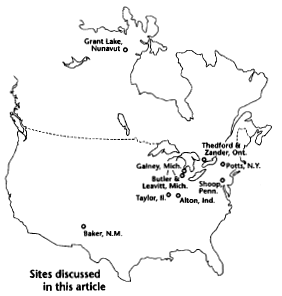
Our research indicates that the entire Great Lakes region (and beyond) was subjected to particle bombardment and a catastrophic nuclear irradiation that produced secondary thermal neutrons from cosmic ray interactions.
The neutrons produced unusually large quantities of 239Pu and substantially altered the natural uranium abundance ratios (235U/238U) in artifacts and in other exposed materials including cherts, sediments, and the entire landscape.
These neutrons necessarily transmuted residual nitrogen (14N) in the dated charcoals to radiocarbon, thus explaining anomalous dates.
The evidence from dated materials
We investigated a cluster of especially young radiocarbon dates concentrated in the north-central area of North America.
For example, at the Gainey site in Michigan a 2880 yr B.P. radiocarbon date was reported, while the thermoluminescence date for that site is 12,400 yr B.P. (5) Other anomalous dates found at Leavitt in Michigan, (6) Zander and Thedford in Ontario, (7) Potts in New York, (8) Alton in Indiana, (9) and Grant Lake in Nunavut (10) are summarized in Table 1.
The Grant Lake Paleoindian site is most remarkable because its 160 [rc] yr B.P. age is nearly contemporary, while adjacent and deeper samples give ages of 1480-3620 [rc] yr B.P.
Stratigraphic associations place Paleoindian occupations at depth on the prehistoric North American landscape on sediments that form the old C horizon composed of parent material, Wisconsinan deposits that predate Holocene sediment buildup. (11)(12)(13) The young Paleoindian dates cannot be correct, particularly since there are no patterned anomalies noted in later-period prehistoric assemblages relating to higher stratigraphic positions.
In a pioneering study of the Paleoindian site at Barnes, Michigan, Wright and Roosa observed that Paleoindian artifacts were deposited before the formation of spodosols ceased in this area about 10,000 yr B.P. (14)
This conclusion was based on observing that cemented sediments on artifacts, found outside their original context, defines their original stratigraphic position.
The evidence from particle bombardment
Sediment profiles were taken at Paleoindian sites and at numerous widely separated control locations in Michigan.
The C sediment horizon is clearly recognized by its transitional color and confirmed by elevated concentrations of potassium and other isotopes. Color and chemistry are key indicators of this very old soil (11)(12)(13)(14) derived from parent materials and associated postglacial runoff. (15) At Gainey, large quantities of micrometeorite-like particles appear to be concentrated near the boundary between the B and C sediment horizons.
They can be separated with a magnet and are identified by the presence of chondrules and by visual evidence of sintering and partial melting. These particles, dissimilar to common magnetites, are found in association with a high frequency of "spherules." The depth profiles for potassium and particles at the Gainey site are compared in Fig. 1.
Minor vertical sorting of particles is apparent, with a shallow spike of particles near the surface probably resulting from modern agricultural or industrial activity. Total gamma-ray counting of sediment profiles in the various locations invariably showed increased radioactivity at the B-C boundary consistent with enhanced potassium (40K) and possibly other activities.
Microscopic examination of chert artifacts from several widely separated Paleoindian locations in North America revealed a high density of entrance wounds and particles at depths that are evidence of high-velocity particle bombardment. Chondrules were identified visually; their presence necessarily indicates heating during high-speed entry into the atmosphere.
The depth of penetration into the artifacts implies that the particles entered with substantial energy. (16) Field simulations with control cherts for large particles (100-200 microns) suggest an entrance velocity greater than 0.4 km/s, and experiments at the National Superconducting Cyclotron Laboratory indicate that the smaller particles left tracks comparable to about 526 MeV iron ions (56Fe) in Gainey artifacts.
Similar features are not observed in later-period prehistoric artifacts or in bedrock chert sources. Track angles were estimated visually; track densities were measured with a stage micrometer; track depths were found by adjusting the microscope focus through the track.
These data are summarized in Table 1.
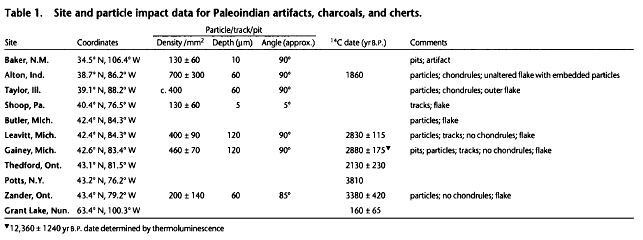
Track and particle data in Table 1 suggest that the total track volume (density times depth) is highest at the Michigan, Illinois, and Indiana sites and decreases in all directions from this region, consistent with a widespread catastrophe concentrated over the Great Lakes region.
The nearly vertical direction of the tracks left by particle impacts at most sites suggests they came from a distant source.
A barn is a unit of area equal to 10-24 cm2, used in nuclear physics. The fraction of isotopes that are transformed by a nuclear reaction is given by s x I, where s is the cross section in cm2 of the target presented by an atom, and I is the neutron flux per cm2 impinging on the target. Most neutron-induced reactions involve the capture of a neutron to produce a heavier isotope of the same element.
Exceptions include 14N, which captures a neutron and emits a proton to produce 14C; and 235U, which mainly fissions into two lighter elements.
The relative size of isotopes in chert is shown in figure "A neutron's view of chert."
The evidence from uranium and plutonium
Natural uranium, which is ubiquitous in cherts, has a 235U/238U isotopic ratio of 0.72 percent, which varies by less than 0.1 percent in natural sources. (17)
Significant variations in the isotopic ratio do not occur because of chemical processes; however, a thermal neutron bombardment depletes 235U and thus alters the ratio. Solar or galactic cosmic rays interacting with matter produce fast secondary neutrons that become thermalized by scattering from surrounding materials.
Thermal neutrons see a target of large cross section (681 barns) A for destroying 235U, compared with a target of only 2.68 barns for neutron capture on 238U. Therefore, despite the low abundance of 235U, about 1.8 times as many 235U atoms are destroyed as 238U atoms by thermal neutrons.
If a large cosmic-ray bombardment impacted the earth and irradiated the prehistoric landscape with thermal neutrons, the 235U/238U ratio would be changed; 239Pu would be produced from neutron capture on 238U, followed by the decay of 239U. Neutrons colliding with nitrogen (1.83 barns) would create 14C in exactly the same way 14C is normally produced in the upper atmosphere, necessarily resetting the radiocarbon dates of any organic materials lying near the surface on the North American prehistoric landscape--including charcoals at Paleoindian sites--to younger values.
239Pu produced during the bombardment will also be partly destroyed by thermal neutrons with 1017 barn cross section.
Assuming 239Pu doesn't mobilize, it will decay back to 235U (half-life 24,110 yr), partially restoring the normal abundance.
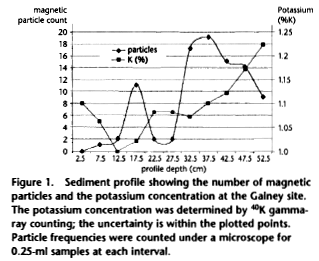
Paleoindian artifacts from Gainey, Leavitt, and Butler, and two later-period artifacts from the same geographic area of Michigan were analyzed for 235U content by gamma-ray counting at the Phoenix Memorial Laboratory, University of Michigan.
They were compared with identical chert types representative of the source materials for the artifacts. Control samples were extracted from the inner core of the purest chert known to be utilized by prehistoric people.
The Paleoindian artifacts contained about 78 percent as much 235U as the controls and later-period artifacts, suggesting substantial depletion. Depletion of 235U necessarily indicates that thermal neutrons impacted these artifacts and the surrounding prehistoric landscape.
Various artifacts, cherts, sediments, and a control sample containing about 0.2 percent uranium obtained from uraninite were sent to the McMaster University Centre for Neutron Activation Analysis to determine 235U concentration by delayed neutron counting and 238U concentration by activation analysis. These results are shown in Table 2. The 235U/238U ratios for all samples except the control deviated substantially from the expected ratio.
McMaster ran additional calibration standards and has considerable expertise analyzing low-level uranium.
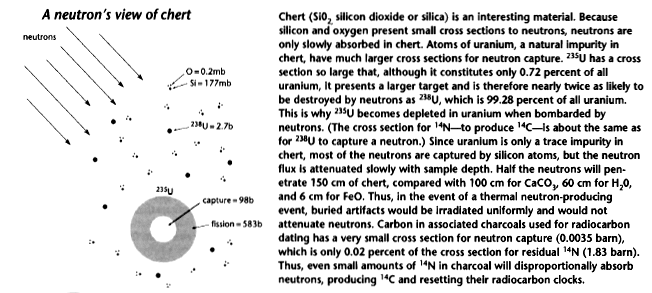
This analysis was sensitive to a few ppb for 235U and 0.1-0.3 ppm for 238U, more than sufficient to precisely analyze the uranium-rich chert samples (0.7-163.5 ppm).
Most samples were depleted in 235U, depletion increasing geographically from the southwest (Baker, Chuska chert, 17 percent) to the northeast (Upper Mercer, 77 percent), as shown in Table 2.
This is consistent with cosmic rays focused towards northern latitudes by Earth's magnetic field. Only a very large thermal neutron flux, greater than 1020 n/cm2, could have depleted 235U at all locations.
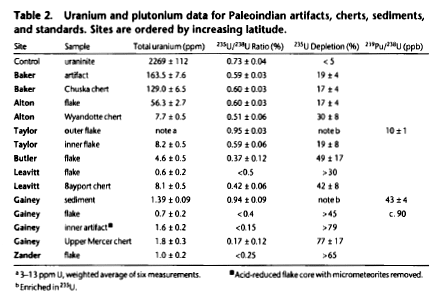
Samples of unaltered flakes from Taylor and sediment originally adjacent to Gainey artifacts showed 235U enriched by 30 percent.
Both samples were closely associated with the particles described above. The position of these samples appears to be related to the enrichment, which cannot be explained by thermal neutrons from the bombardment. To test this, we bathed another Taylor flake in 48-percent HF at 60°F for ten minutes to remove the outer 70 percent of the sample and the attached particles. Analysis showed the "inner" flake depleted in 235U by 20 percent, consistent with the other depleted cherts.
Samples of Gainey sediment and Taylor flakes were analyzed for plutonium by Nuclear Technology Services, Inc., of Roswell, Georgia, which specializes in radiochemistry using standard methodology. The plutonium, with an aliquot of NIST-traceable 242Pu added, was chemically separated on an anion exchange resin column and counted on an alpha-particle spectrometer. The 239Pu/238U ratios in both samples were approximately 10 ppb, vastly exceeding the expected ratio of 0.003 ppb. (18) The results of this analysis are shown in Table 2.
Chert is a glass-like material highly impervious to penetration by any nuclear fallout that might also contribute 239Pu. We analyzed a long-exposed piece of Bayport chert by gamma-ray counting at the LBNL low-background facility for the presence of cesium-137 (137Cs), a key indicator of fallout (from nuclear testing), and found none. The B-C interface typically lies sufficiently deep that contamination by fallout is improbable. It is important to note that fallout cannot explain the depletion of 235U.
Since the depletion of 235U must have resulted from bombardment by thermal neutrons, the presence of 239Pu from irradiation of 238U is expected. The total thermal neutron flux required to produce the observed 239Pu concentration can be calculated from the relative concentrations of 239Pu (corrected for the decay) and 238U, and the thermal neutron-capture cross section for 238U.
This neutron flux can then be used to estimate the amount of additional 14C that would have been produced in charcoal by neutrons colliding with 14N (14N cross section = 1.83 barns).
The corrected radiocarbon age can then be estimated by comparing the current amount of 14C in the dated charcoals, determined from their measured radiocarbon age, with the amount of 14C that would have been produced by the bombardment. For these calculations we assume that charcoal contains 0.05 percent residual nitrogen (19) and that initial 14C concentrations were the same as today (one 14C atom for 1012 12C atoms).
We derive a thermal neutron flux of c. 1017 n/cm2 at Gainey, which corresponds to an approximate date of 39,000 yr B.P. No radiocarbon date is available for the more southerly Taylor site, but for the conventional range of accepted Paleoindian dates the neutron flux would be c. 1016 n/cm2, giving a date of about 40,000 yr B.P. These calculations necessarily neglect differences in the neutron flux experienced by the dated charcoal and the artifacts, the effects of residual 239Pu from previous bombardments, and loss of 239Pu due to leaching from chert over time.
The neutron flux calculated from the 235U/238U ratio is more than 1000 times that implied by the level of 239Pu. Since 239Pu decays to 235U, partly restoring the natural abundance, it appears that substantial quantities of 239Pu have migrated out of the chert.
This mobility is demonstrated at the Nevada Test Site, where plutonium, produced in nuclear tests conducted by the U.S. between 1956 and 1992, migrated 1.3 km. (20)
It has also been shown that atoms produced by radioactive decay or nuclear reaction become weakly bound to the parent material and pass more readily into solution than isotopes not affected. (21) Both 239Pu and 235U are thus expected to be mobile, complicating any analysis. This is consistent with the enrichment of 235U in the two external samples where migrating 239Pu or 235U may have been trapped, thus enriching the relatively uranium-poor outer regions. Alternatively, excess 235U may have been carried in by the particles. Radiocarbon produced in situ by irradiation should also be mobile.
If 14C is more mobile than 239Pu, then the dates calculated above should be decreased accordingly.
Redating North American sites
The 39,000 yr B.P. date proposed for the Gainey site is consistent with the prevailing opinion among many archaeologists about when the Americas were populated. It is also commensurate with dates for South American sites and with a Mousterian toolkit tradition that many see as the Paleoindian precursor.
The proposed date for the Gainey site also falls closer in line with the radiocarbon date for a Lewisville, Texas, Paleoindian site of 26,610 ± 300 yr B.P. (22)(23)(24) and radiocarbon dates as early as c. 20,000 yr B.P. for Meadowcroft Rockshelter. Since the Lewisville and Meadowcroft sites were likely exposed at the same time to thermal neutrons, we estimate that their dates should be reset to c. 55,000 yr B.P. and c. 45,000 yr B.P., respectively.
It is likely that Paleoindians occupied low latitudes during the full glacial and migrated to more northerly areas as the ice front retreated. Therefore the pattern of dates makes sense from the archaeologist's point of view. Dates for North American sites should generally be reset by up to 40,000 years, depending on latitude and overburden.
Geologists believe that before c. 15,000 yr B.P. the Wisconsinan glaciation covered the more northerly locations where Paleoindian sites have been found. (25) The ice sheet would have shielded the landscape and any artifacts from an irradiation.
(The Gainey thermoluminescence date of 12,400 yr B.P. is probably a result of the heat generated by the nuclear bombardment at that time, which would have reset the TL index to zero.)
The modified dates for Paleoindian settlements suggest that the timetable for glacial advance sequences, strongly driven by conventional radiocarbon dates, should be revisited in light of the evidence presented here of much older occupations than previously thought."
The alignment of magnetic particles in sediment indicates that the Earth's magnetic poles have repeatedly reversed their polarity in the past. Complete magnetic excursions occurred about 10 times in 4.5 million years; the last reversal occurred about 700,000 years ago.
Magnetic excursions occur every 10,000-20,000 years when the Earth's magnetic field becomes weak, and the poles may even reverse for a short time.
The evidence from tree rings and marine sediments
A large nuclear bombardment should have left evidence elsewhere in the radiocarbon record. It is well known that radiocarbon dates are increasingly too young as we go back in time.
The global Carbon Cycle suggests that 14C produced by cosmic rays would be rapidly dispersed in the large carbon reservoirs in the atmosphere, land, and oceans. (26)
We would expect to see a sudden increase in radiocarbon in the atmosphere that would be incorporated into plants and animals soon after the irradiation; after only a few years, most of the radiocarbon would move into the ocean reservoirs. The 14C level in the fossil record would reset to a higher value.
The excess global radiocarbon would then decay with a half-life of 5730 years, which should be seen in the radiocarbon analysis of varved systems.
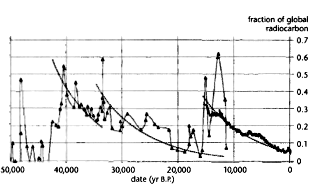
Fig. 2 plots 14C from the INTCAL98 radiocarbon age calibration data of Stuiver et al. for 15,000-0 yr B.P. (27) and Icelandic marine sediment 14C data measured by Voelker et al. for 50,000-11,000 yr B.P. (28)
Excess 14C is indicated by the difference between the reported radiocarbon dates and actual dates. Sharp increases in 14C are apparent in the marine data at 40,000-43,000, 32,000-34,000 and c. 12,000 yr B.P
These increases are coincident with geomagnetic excursions B that occurred at about 12,000 (Gothenburg), 32,000 (Mono Lake), and 43,000 yr B.P. (Laschamp), (29) when the reduced magnetic field would have made Earth especially vulnerable to cosmic ray bombardment. The interstitial radiocarbon data following the three excursions were numerically fit, assuming exponential decay plus a constant cosmic ray-produced component. The fitted half-lives of 5750 yr (37,000-34,000 yr B.P.), 6020 yr (32,000-16,000 yr B.P.), and 6120 yr (12,000-0 yr B.P.) are in good agreement with the expected value.
We also determined that contemporary radiocarbon contains about 7 percent residual 14C left over from the catastrophe. The constant cosmic ray production rate was about 34 percent higher for the Icelandic sediment than the INTCAL98 samples, perhaps implying higher cosmic ray rates farther north. Disregarding fluctuations in the data from variations in ocean temperatures and currents, the results are clearly consistent with the decay of radiocarbon following the three geomagnetic excursions.
In Fig. 2, the sharp drop in 14C activity before 41,000 yr B.P. suggests that global radiocarbon increased by about 45 percent at that time and by about 20 percent at 33,000 and 12,000 yr B.P The results are remarkably consistent with Vogel's comparison of 14C and U-Th dates of a stalagmite that indicates global radiocarbon increased about 75 percent from 30,000 to 40,000 yr B.P. and about 30 percent around 18,000 yr B.P. (30)
McHargue et al. found high levels of 10Be in Gulf of California marine sediments at 32,000 and 43,000 yr B.P.C that could not be explained by magnetic reversal alone and were attributed to cosmic rays, possibly from a supernova. (29) The geomagnetic excursion at 12,500 yr B.P. coincides with the thermoluminescence date from Gainey, and additional evidence for a cosmic ray bombardment at that time is found in the increases of 10Be, (31) Ca, (32) and Mg32 in Greenland ice cores around 12,500 yr B.P. Similar increases are also seen in the data for NO3-, SO4-, Mg+, Cl-, K+, and Na+ ions in Greenland ice cores. (33)
This occurrence can be dated precisely to 12,500 ± 500 yr B.P., an average of the remarkably consistent concentration peak centroids in the Greenland ice core data. Significant increases at that time are not found in comparable data for the Antarctic, which indicates that the cosmic ray irradiation was centered in the Northern Hemisphere. Weak evidence of an occurrence at 12,500 yr B.P. is seen in the radiocarbon record for marine sediments near Venezuela, (34) confirming that the cosmic ray bombardment was most severe in northern latitudes.
Lunar cosmogenic data also show evidence of increased solar cosmic ray activity at or before 20,000 yr B.P. (35)(36) although these data are not sensitive to earlier irradiation.
Beryllium occurs naturally as 9Be. 10Be is produced by cosmic rays, mostly protons, striking the atmosphere and breaking apart nitrogen and oxygen. It has a half-life of 1.5 million years. Unlike 14C, which is caught up in the global Carbon Cycle, 10Be is inert and falls as dust. 10Be is produced almost entirely by galactic cosmic rays, which are much higher in energy than solar cosmic rays.
Thus any increase in 10Be would be cosmic in origin; and the cosmic ray rate could only change if there were a nearby supernova. During the last Ice Age the 10Be deposition rate in ice at both poles was much higher than today. Gulf of California marine sediments clearly show strong (10).
Be peaks at 32,000 and 43,000 yr B.P. McHargue argues that these peaks can only be explained by a supernova.
The effect of a supernova on Earth
Sonett suggests that a single supernova would produce two or three shock waves, an initial forward shock and a pair of reverse shocks from the initial expansion and a reflected wave from the shell boundary of a more ancient supernova.39,40
Fig. 2 shows that each episode in a series produced a similar amount of atmospheric radiocarbon.
The sun lies almost exactly in the center (41) of the Local Bubble, believed to be the result of a past nearby supernova event. A candidate for the reverse shock wave is the supernova remnant North Polar Spur, with an estimated age of 75,000 years and a distance of 130 ± 75 parsecs (424 light years), (42) conveniently located in the north sky from where it would have preferentially irradiated the Northern Hemisphere.
Assuming the Taylor flux is average and 1,000 neutrons are produced per erg of gamma-ray energy, (43) the catastrophe would have released about 1016 erg/cm2 (2 x 108 cal/cm2), corresponding to a solar flare of 1043 ergs or a gamma-flash of 1054 ergs from a supernova about 1 parsec away.

The geographical distribution of particle tracks, 235U depletion, and 239Pu concentration shown in Fig. 3 are quite consistent, although the particle tracks seem to be confined to a smaller geographic area.
They indicate energy released over the northeastern sector of the U.S., with maximum energy at about 43° N, 85° W, the Michigan area of the Great Lakes region.
A history of suspected cosmic cataclysms over the ages
Wdowczyk and Wolfendale (44) and Zook (36) propose, based on the existing record of solar flare intensities, that solar flares as large as 3 x 1038 ergs should be expected every 100,000 years.
Clark et al. estimate that supernovas release 1047-1050 ergs within 10 parsecs of Earth every 100 million years. (45) Brackenridge suggests that a supernova impacted the earth in Paleoindian times. (46)
Damon et al. report evidence from the 14C tree ring record that SN1006, which occurred at a distance of 1300 parsecs, produced a neutron shower of 2 x 108 n/cm2. (47) Castagnoli et al. report evidence of the past six nearby supernovae from the thermoluminescence record of Tyrrhenian sea sediments. (48)
Dar et al. suggest that a cosmic ray jet within 1000 parsec would produce 1012 muons/cm2 (greater than 3 x 109 eV) and 1010 protons and neutrons/cm 2 (greater than 106 eV) and deposit over 1012 erg/cm2 in the atmosphere every 100 million years. (49) A cosmic ray jet is also predicted to produce heavy elements via the r-process and could be a source of 235U enriched up to 60 percent in uranium.
The Paleoindian catastrophe was large by standards of all suspected cosmic occurrences. Normal geomagnetic conditions would focus cosmic rays towards the magnetic poles, concentrating their severity in those regions. However, low magnetic field intensity during a geomagnetic excursion may have allowed excessive cosmic rays to strike northeastern North America. (Whether the geomagnetic excursion admitted cosmic radiation, or the radiation caused the excursion, is uncertain. Given our present state of knowledge, cause and effect in this instance are unclear.)
The presence of a nearby small and dense interstellar cloud may explain the origin of the particle bombardment. (50) The size of the initial catastrophe may be too large for a solar flare, but a sufficiently powerful nearby supernova or cosmic ray jet could account for it.
It appears that the catastrophe initiated a sequence of events that may have included solar flares, impacts, and secondary cosmic ray bombardments.
A devastating effect on Earth
The enormous energy released by the catastrophe at 12,500 yr B.P. could have heated the atmosphere to over 1000°C over Michigan, and the neutron flux at more northern locations would have melted considerable glacial ice. Radiation effects on plants and animals exposed to the cosmic rays would have been lethal, comparable to being irradiated in a 5-megawatt reactor more than 100 seconds.
The overall pattern of the catastrophe matches the pattern of mass extinction before Holocene times. The Western Hemisphere was more affected than the Eastern, North America more than South America, and eastern North America more than western North America. (51)(52)(53) Extinction in the Great Lakes area was more rapid and pronounced than elsewhere.
Larger animals were more affected than smaller ones, a pattern that conforms to the expectation that radiation exposure affects large bodies more than smaller ones. (54)(55)
Sharp fluctuations of 14C in the Icelandic marine sediments at each geomagnetic excursion are interesting; because global carbon deposits in the ocean sediments at a rate of only about 0.0005 percent a year, a sudden increase in sediment 14C may reflect the rapid die-off of organisms that incorporated radiocarbon shortly after bombardment.
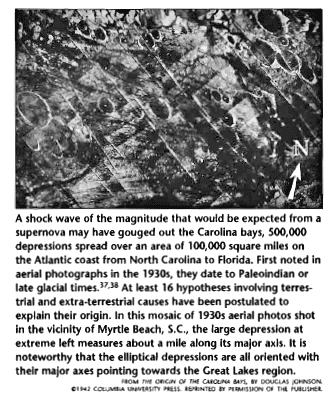
Massive radiation would be expected to cause major mutations in plant life. Maize probably evolved by macro-mutation at that time, (55)(56) and plant domestication of possibly mutated forms appears worldwide after the Late Glacial period.
For example, there was a rapid transition from wild to domesticated grains in the Near East after the catastrophe. (57)
Implications for future study
Much of what we assume about the Paleoindian period and the peopling of the Americas has been inferred from conventional radiocarbon chronology, which often conflicts with archaeological evidence.
This work mandates that conventional radiocarbon dates be reinterpreted in light of hard terrestrial evidence of exposure of the radiocarbon samples to a cosmological catastrophe that affected vast areas of North America and beyond.
A nuclear catastrophe can reset a group of unrelated artifacts to a common younger date, creating gaps and false episodes in the fossil record. Geographical variation and complicated overburdens may further confuse the interpretation.
Scrutiny of Paleoindian artifacts and the North American paleolandscape, associated stratigraphic sediments, coupled with continued radiological investigations, may provide more evidence for the cosmic catastrophe and new clues to the origin of Paleoindians.
References
(0) Original Source: Center First Americans
(1) Gruhn, R., in Clovis: Origins and Adaptations, R. Bonnichsen, K. L. Turnmire, eds. (Oregon State University Press, Corvallis, 1991), pp. 283-286.
(2) Muller-Beck, H., Science 152, 1191 (1985).
(3) Bonnichsen, R., in Clovis: Origins and Adaptations, R. Bonnichsen, K. L. Turnmire, eds. (Oregon State University Press, Corvallis , 1991), pp. 309-329.
(4) Bonnichsen, R., F. Will, in Ice Age Peoples of North America, R. Bonnichsen, K. L. Turnmire, eds. (Oregon State University Press, Corvallis, 1999), pp. 395-415.
(5) Simons, D. B., M. J. Shott, H. T. Wright, Arch. East. Nor. Amer. 12, 266 (1984).
(6) Shott, M.J., The Leavitt Site (Museum of Anthropology, Ann Arbor, 1993).
(7) Stewart, A., Ontario Arch. 41, 45 (1984).
(8) Gramly, R. M., J. Lothrop, Arch. East. Nor. Amer. 12, 1222 (1984).
(9) Tomak, C. H., Dancey Ohio Arch. Coun., Columbus, 117 (1994).
(10) Wright, J. V., Borden Number Kkln-2, Lab No. S-833. Canadian Archaeology Association C14 Database Search, http://www.canadianarchaeology.com/localc14/c14search.htm
(11) S. Boggs, S., Principles of Sedimentology and Stratigraphy (MacMillan, New York, 1987).
(12) Easterbrook, D. J., Surface Processes and Landforms (MacMillan, New York, 1993).
(13) Birkeland, P. W., Soils and Geomorphology (Oxford University Press, New York, 1984).
(14) Wright, H. T., W. B. Roosa, American Antiquity 31, 850 (1966).
(15) Turner, M. D., E. J. Zeller, G. A. Dreschoff, J. C. Turner, in Ice Age Peoples of North America, R. Bonnichsen, K. L. Turnmire, eds. (Oregon State University Press, Corvallis, 1999), pp. 42-77.
(16) firestone, R. B., W. Topping, Paleoindian Nuclear Event, http://ie.lbl.gov/Paleo/paleo.html
(17) Kuroda, P. K., The Origin of the Chemical Elements, (Springer-Verlag, Berlin Heidelberg, 1982).
(18) Seaborg, G. T., W. D. Loveland, The Elements beyond Uranium, (John Wiley & Sons, Inc., New York, 1990).
(19) Ostrom, N., analysis at Michigan State University of charcoal and wood dated at 2800 and 42,000 yr B.P. respectively, private communication.
(20) Kersting, A. B., et al., Nature 397, 56 (1999).
(21) Cherdyntsev, V. V., Abundance of Chemical Elements. (The University of Chicago Press, Chicago, translated by W. Nichiporuk, 1961).
(22) Wormington, H. M., Ancient Man in North America, (The Denver Museum of Natural History, Denver, 1957).
(23) Shirley, R. H., et al., Environmental Geology Notes 109, 1985.
(24) Adovasio, J. M., R. C. Carlisle, Science 239, 713 (1988).
(25) Farrand, W. R., The Glacial Lakes around Michigan, Bulletin 4. (Geological Survey Division, Michigan Department of Environmental Quality, 1988). http://www.deq.state.mi.us/gsd/Gltext.html
(26) Schimel, D. S., et al., in Climate Change 1994. Radiative Forcing of Climate Change and An Evaluation of the IPCC IS92 Emission Scenarios, J. T. Houghton, L. G. M. Filho, J. Bruce, H. Lee, B. A. Callander, E. Haites, N. Harris, and K. Maskell, eds. (IPCC Report. Cambridge University Press, Cambridge, 1994).
(27) Stuiver, M., et al., Radiocarbon 40, 1041 (1998).
(28) Voelker, A. H. L., et al., Radiocarbon 40, 517 (1998).
(29) McHargue, L. R., P. E. Damon, D. J. Donahue, Geophys. Res. Lett. 22, 659 (1995).
(30) Vogel, J. C., Radiocarbon 25, 213 (1983).
(31) Finkel, R. C., K. Nishiizumi, J. Geophys. Res. 102, 26699 (1997).
(32) De Angelis, M., J. P. Steffensen, M. R. Legrand, H. B. Clausen, C. U. Hammer, Journal of Geophysical Research 102, 26681 (1997).
(33) Mayewski, P. A., et al., Journal of Geophysical Research 102, 26345 (1997).
(34) Hughen, K. A., et al., Radiocarbon 39, 483 (1998).
(35) Jull, A. T., et al., Geochimica et Cosmochimica Acta 62, 3025 (1998).
(36) Zook, H. A., Proc. Conf. Ancient Sun, J. A. Eddy, R. Merrill, eds., 245 (1980).
(37) Prouty, W. F., Geol. Soc. Am. Bull. 63, 167 (1952).
(38) Eyton, J. R., J. L. Parkhurst, A Re-Evaluation of the Extraterrestrial Origin of the Carolina Bays, http://abob.libs.uga.edu/bobk/cbayint.html (1975).
(39) Sonett, C. P., G. E. Morfill, J. R. Jokipii, Nature 330, 458 (1987).
(40) Sonett, C. P., Radiocarbon 34, 239 (1992).
(41) Davelaar, J., J. A. M. Bleeker, A. J. M. Deerenberg, Astron. Astrophys. 92, 231 (1980).
(42) Lingenfelter, R. E., R. Ramaty, in Radiocarbon Variations and Absolute Chronology, I. U. Olson, ed. (John Wiley & Sons, New York, 1970), pp. 513-537.
(43) Wdowczyk, J., A.W. Wolfendale, Nature 268, 510 (1977).
(44) Clark, D. H., W. H. McCrea, F. R. Stephenson, Nature 265, 318 (1977).
(45) Brackenridge, G. R., Icarus 46, 81 (1981).
(46) Damon, P. E., D., Kaimei, G. E. Kocharov, J. B. Mikheeva, A. N. Peristykh, Radiocarbon 37, 599 (1995).
(47) Castagnoli, G. C., G. Bonino, and S. Miono, Nuovo Cimento 5C, 488 (1982).
(48) Dar, A., A. Laor, N. J. Shaviv, Phys. Rev. Lett. 80, 5813 (1998).
(49) Frisch, P. C., American Scientist 88 (2000).
(50) Guilday, J. E., P. S. Martin, Pleistocene Extinctions, the Search for a Cause, P. S. Martin, H. E. Wright, eds. (Yale University Press, New Haven,1967) pp. 5-120.
(51) Meltzer, D. J., T. I. Mead, Quat. Res. 19, 130 (1983).
(52) Robinson, A., Earth Shock (Thames and Hudson, Ltd, London, 1993).
(53) Farrand, W. R., Science 133, 729 (1961).
(54) Sanderson, I. T., Sat. Evening Post 232, 82 (1960).
(55) Iltis, H. H., Science 222, 886 (1983).
(56) Benz, F. F., H.H. Iltis, Amer. Antiq. 55, 500 (1990).
(57) Murray, J., The First European Agriculture (Edinburgh University Press, Edinburgh, 1970).
The M+G+R Foundation
Disclaimer |
About Us | Frequently Asked
Questions | Contact | If this is your
first visit: Introduction | If you are a regular
visitor: Home Page |
Español | Portugues
| Back Up Home Page | To search for
information: Search Page |
Index of Documents
Please Note: If the above dated image does not appear on this document, it means that you are not viewing the original document from our servers. Should you have reason to doubt the authenticity of the document, we recommend that you access our server again and click on the "Refresh" or "Reload" button of your Browser to view the original document.